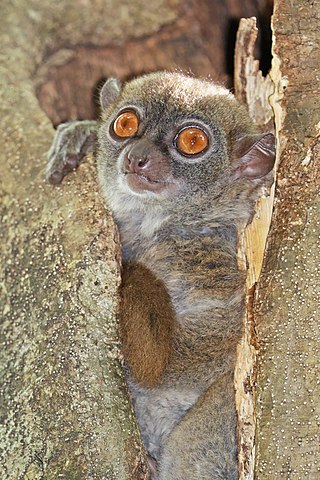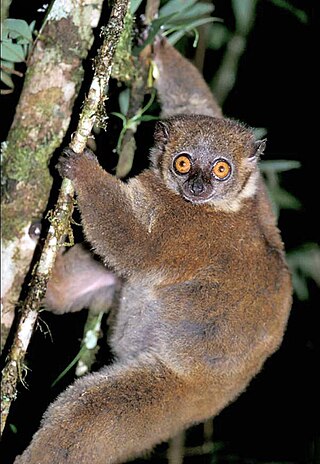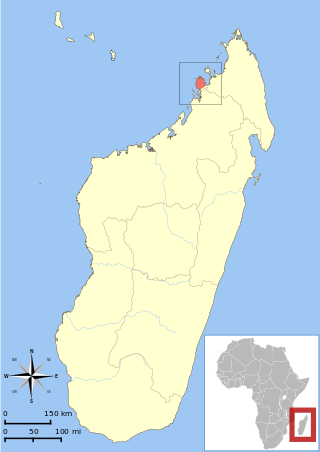
The sportive lemurs are the medium-sized primates that make up the family Lepilemuridae. The family consists of only one extant genus, Lepilemur. They are closely related to the other lemurs and exclusively live on the island of Madagascar. For a time, this family was named Megaladapidae, but the current name was given precedence since the extinct genus Megaladapis was removed from the family.

The eastern lesser bamboo lemur, also known as the gray bamboo lemur, the gray gentle lemur, and the Mahajanga lemur is a small lemur endemic to Madagascar, with three known subspecies. As its name suggests, the eastern lesser bamboo lemur feeds mainly on bamboo. The lemurs of the genus Hapalemur have more manual dexterity and hand–eye coordination than most lemurs. They are vertical climbers and jump from stalk to stalk in thick bamboo forests.

The gray-backed sportive lemur, also known as Gray's sportive lemur or back-striped sportive lemur, is a species of lemur in the family Lepilemuridae. It is endemic to Madagascar. It is threatened by habitat loss.

The white-footed sportive lemur, white-footed weasel lemur, or dry-bush weasel lemur is a species of lemur in the family Lepilemuridae, the sportive lemurs. It is similar in appearance to other lemurs in the family, with a grey back, a pale grey to white ventral side, and a light brown tail. It is a nocturnal animal that moves through the forest using a vertical clinging and leaping technique. It is endemic to Madagascar, inhabiting the southern subtropical or tropical dry shrubland. It is threatened by habitat loss due to agriculture practices and charcoal production.

The small-toothed sportive lemur, or small-toothed weasel lemur, is a primate species in the family Lepilemuridae that—like all extant lemurs—is endemic to Madagascar. The species lives in dense rainforest in southeastern Madagascar, and can be found in Ranomafana and Andringitra National Parks. Described in 1894, it was considered either a subspecies or taxonomic synonym of the weasel sportive lemur throughout most of the 20th century. Phylogenetic studies not only support its species status, but also suggest that it is the only eastern Malagasy sportive lemur that is more closely related to western than to other eastern species.

The Ankarana sportive lemur, or Ankarana weasel lemur, is a sportive lemur endemic to Madagascar. It is one of the smaller sportive lemurs with a total length of about 53 cm (21 in), including 25 cm (9.8 in) of tail. Average body weight is approximately 750 grams (1.65 lb). The Ankarana sportive lemur is found in northern Madagascar, living in dry lowland forests in Ankarana, Andrafiamena and Analamerana, and in moist montane forest of Montagne d'Ambre.

The Sahamalaza sportive lemur is a species of sportive lemur endemic to northern Madagascar.

Grewcock's sportive lemur, or the Anjiamangirana sportive lemur, is a sportive lemur endemic to Madagascar. It is a medium-sized sportive lemurs with a total length of about 55 to 63 cm, of which 26–30 cm (10–12 in) are tail. Grewcock's sportive lemur is found in northwestern Madagascar, living in dry deciduous forests.

The Antafia sportive lemur, or red-shouldered sportive lemur is a sportive lemur endemic to Madagascar. It has a total length of about 52 to 59 cm, of which 24–26 cm (9.4–10.2 in) are tail. The AEECL's sportive lemur is found in western Madagascar, living in dry deciduous forests.

Ahmanson's sportive lemur, or the Tsiombikibo sportive lemur, is a sportive lemur endemic to Madagascar. It is a relatively small sportive lemur with a total length of about 47 to 54 cm, of which 23–25 cm (9.1–9.8 in) are tail. Wright's sportive lemur is found in western Madagascar, living in dry forests.

Randrianasolo's sportive lemur, or the Bemaraha sportive lemur, is a sportive lemur endemic to Madagascar. It has a total length of about 49 to 56 cm, of which 21–26 cm (8.3–10.2 in) are tail. Randrianasolo's sportive lemur is found in western Madagascar.

Petter's sportive lemur is a sportive lemur endemic to Madagascar. It is one of 26 species in the genus Lepilemur. It is one of the smaller sportive lemurs with a total length of about 49 to 54 cm, of which 22–25 cm (8.7–9.8 in) are tail. Petter's sportive lemur is found in southwestern Madagascar, living in dry spiny forests and some gallery forests.

The Daraina sportive lemur is a sportive lemur endemic to Madagascar. It is a relatively small sportive lemur with a total length of about 49 to 56 cm, of which 24–27 cm (9.4–10.6 in) are tail.

Ramanantsoavana's woolly lemur, also known as Ramanantsoavana's avahi or the Manombo woolly lemur, is a species of woolly lemur native to southeastern Madagascar. It weighs about 1 kg. It was originally considered a subspecies of the southern woolly lemur, A. m. ramanantsoavana, but was elevated to a separate species in 2006 based on molecular, phenotypic and morphological data.

Mittermeier's sportive lemur is a sportive lemur endemic to the Ampasindava Peninsula in Madagascar.
Yves Rumpler, is a French researcher and primatologist. He was a professor of embryology and primatology at the Louis Pasteur University of Strasbourg until he retired in 2007.

Holland's sportive lemur, or the Mananara-Nord sportive lemur, is a sportive lemur that is endemic to Madagascar. It is one of 26 species in the genus Lepilemur. This lemur is found specifically in the Mananara-Nord Biosphere Reserve, but the limits of its habitat have yet to be determined. It lives in primary and secondary rainforests. Holland's sportive lemur was described in 2009.

Lemurs were first classified in 1758 by Carl Linnaeus, and the taxonomy remains controversial today, with approximately 70 to 100 species and subspecies recognized, depending on how the term "species" is defined. Having undergone their own independent evolution on Madagascar, lemurs have diversified to fill many ecological niches normally filled by other types of mammals. They include the smallest primates in the world, and once included some of the largest. Since the arrival of humans approximately 2,000 years ago, lemurs have become restricted to 10% of the island, or approximately 60,000 square kilometers (23,000 sq mi), and many face extinction. Concerns over lemur conservation have affected lemur taxonomy, since distinct species receive increased conservation attention compared to subspecies.


















